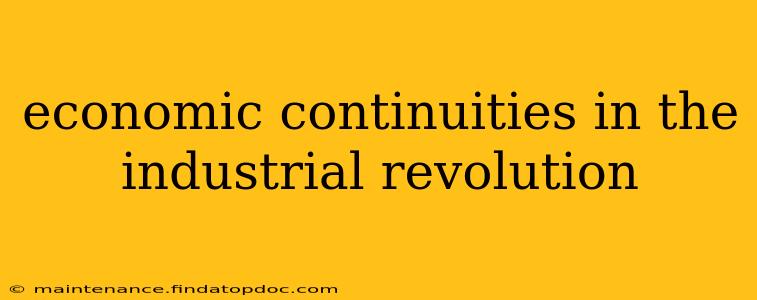The Industrial Revolution, often portrayed as a period of radical transformation, also witnessed significant economic continuities. While technological advancements and factory production fundamentally altered the economic landscape, many pre-existing structures, practices, and inequalities persisted, shaping the new industrial order in profound ways. Understanding these continuities is crucial to gaining a complete picture of this pivotal period in history.
What Were the Main Economic Continuities During the Industrial Revolution?
Several key economic continuities characterized the Industrial Revolution:
-
Persistence of Agriculture: Despite the rise of factories, agriculture remained a dominant sector, employing a large portion of the population. Agricultural practices, while undergoing some modernization, were largely unchanged in many regions. The reliance on agricultural labor and output continued to underpin the overall economy.
-
Continued Importance of Trade: International and domestic trade continued to be vital, connecting regions and fueling industrial growth. Established trade routes and networks facilitated the movement of raw materials and manufactured goods, underpinning the expansion of industrial production and connecting producers with global markets. Existing mercantile systems and trading companies adapted to the new industrial environment, maintaining their influence.
-
Unequal Distribution of Wealth: The Industrial Revolution exacerbated existing inequalities, rather than eliminating them. While some individuals and families accumulated vast fortunes through industrial enterprises, the majority of workers experienced harsh working conditions and low wages. The gap between the wealthy and the poor widened considerably, creating social unrest and shaping social structures.
-
The Enduring Role of Family Businesses: The family remained a central unit of economic organization. Many industrial enterprises were initially family-run businesses, with production often taking place within the family home or in small workshops. While larger factories emerged, family-based businesses continued to play a significant role, especially in smaller-scale industries and regional economies.
-
Regional Economic Disparities: The Industrial Revolution did not lead to uniform economic development across all regions. Certain areas, possessing specific resources, infrastructure, or skilled labor, experienced rapid industrialization, while others remained largely agrarian, perpetuating existing regional disparities in wealth and development.
How Did Pre-existing Economic Structures Influence the Industrial Revolution?
Pre-existing economic structures significantly shaped the trajectory of the Industrial Revolution. For instance:
-
Existing infrastructure: The presence or absence of canals, roads, and ports impacted the ability of regions to participate in industrial development. Areas with well-established infrastructure had a clear advantage in transporting raw materials and finished goods.
-
Access to Capital: Existing financial institutions, such as banks and merchant houses, played a vital role in financing the expansion of industries. Access to credit and investment capital varied across regions and social classes, influencing the distribution of industrial growth.
-
Existing Labor Systems: Pre-industrial labor practices, including apprenticeship systems and the use of child labor, continued into the Industrial Revolution, shaping the structure and dynamics of the new factory system.
-
Mercantilism and Colonialism: Existing mercantile policies and colonial relationships continued to influence trade patterns and resource access. Colonial economies provided essential raw materials for industrial production, sustaining the economic dominance of imperial powers.
What were the Social Impacts of these Continuities?
The persistence of these economic continuities had profound social consequences:
-
Social stratification: The unequal distribution of wealth resulted in stark social divisions, fueling social unrest and the rise of new social movements advocating for workers' rights.
-
Urbanization and overcrowding: Rapid industrialization led to mass migration to urban centers, resulting in overcrowding, poor sanitation, and the spread of disease. These issues were exacerbated by existing inequalities in access to resources and housing.
-
Labor movements: The harsh conditions faced by many industrial workers spurred the growth of labor movements and unions, advocating for improved wages, working conditions, and social reforms.
Conclusion: A Complex Transformation
The Industrial Revolution was a period of both dramatic change and significant continuity. While technological innovations transformed production and economic activity, many pre-existing economic structures, practices, and inequalities persisted, shaping the new industrial order and impacting the social landscape in profound ways. Recognizing these continuities is essential for a comprehensive understanding of the complexities of this transformative era.
